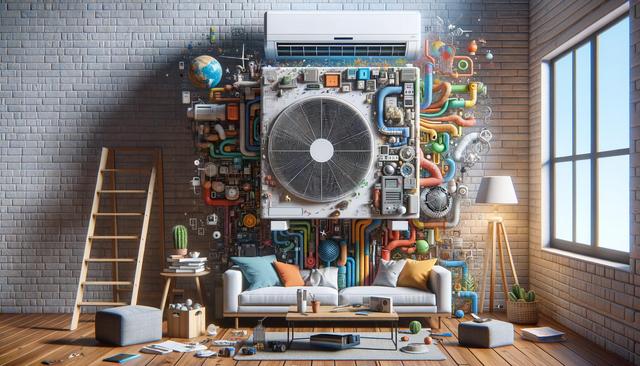Understanding Ductless AC Technology
Ductless air conditioning systems, also known as mini-split systems, operate without the need for traditional ductwork. They consist of two main components: an outdoor compressor unit and one or more indoor air-handling units. These components are connected via a small conduit that houses the power cable, refrigerant tubing, suction tubing, and a condensate drain. The design allows for targeted temperature control in individual rooms or zones, significantly improving energy efficiency and user comfort. With advancements in inverter technology, modern ductless units can adjust cooling output dynamically, maintaining consistent temperatures while using less energy.
This setup eliminates the energy losses commonly associated with ducted systems, which can lose up to 30% of energy through leaks and poor insulation. Ductless systems are particularly useful in homes without existing ductwork or in areas where expanding ducts would be difficult or costly. Their flexibility makes them ideal for retrofitting older homes, converting basements or attics, or adding comfort to room additions.
Cost-Efficiency and Energy Savings
One of the primary reasons homeowners consider a ductless AC upgrade is the potential for long-term cost savings. While the initial installation cost may be higher than window units or portable air conditioners, ductless systems often pay for themselves through lower utility bills. By cooling only the rooms in use and avoiding the inefficiencies of ductwork, these systems contribute to significant energy savings over time.
Here are a few ways ductless systems help reduce costs:
- Targeted zone cooling reduces unnecessary energy use.
- Inverter-driven compressors use only the energy needed for the current load.
- No ductwork means no energy loss through leaks or heat gain.
In addition to energy savings, some regions offer rebates or incentives for installing energy-efficient HVAC systems, further reducing the financial impact of upgrading to ductless air conditioning.
Flexibility and Customization
Ductless AC systems offer a high level of flexibility, making them suitable for a wide range of applications. Whether you’re upgrading an older home, finishing a garage, or building an addition, these systems adapt easily to your needs. Indoor units come in various styles, including wall-mounted, ceiling-recessed, and floor-standing models, allowing for design integration and unobtrusive installation.
Customization is another key advantage. Homeowners can set different temperatures for each zone, creating personalized comfort throughout the house. This is especially beneficial in households where different members have varying temperature preferences. Some systems also offer smart control features, such as remote operation via smartphone apps, programmable timers, and integration with home automation systems.
These features make ductless systems a practical solution for modern living, where adaptability and control are increasingly important.
Ease of Installation and Minimal Disruption
Compared to traditional HVAC systems that require extensive ductwork, the installation of ductless air conditioners is relatively quick and straightforward. The process usually involves mounting the indoor unit, installing the outdoor unit, and connecting them through the conduit. This can often be completed within a day or two, depending on the number of zones being installed.
Key benefits of the minimal installation process include:
- Less structural modification required, preserving the integrity of walls and ceilings.
- Reduced labor costs and shorter installation timelines.
- Minimal dust, debris, and disruption to daily life during installation.
This makes ductless systems particularly appealing for homeowners looking to improve comfort without undergoing major renovations. It’s also a smart choice for older homes where installing ducts would be impractical or damaging to the building’s structure.
Improved Indoor Air Quality and Maintenance
Another often-overlooked benefit of ductless AC systems is their contribution to improved indoor air quality. Traditional ducted systems can circulate dust, allergens, and other pollutants throughout a home, especially if the ducts are not regularly cleaned. Ductless systems, on the other hand, include multi-stage filtration that can significantly reduce airborne particles, bacteria, and odors.
Maintenance is also more straightforward. Most filters are washable and easy to access, meaning homeowners can clean them regularly without professional help. Additionally, because the system components are more accessible, routine servicing and repairs tend to be simpler and faster.
For individuals with allergies or respiratory conditions, the enhanced air filtration capabilities of ductless systems offer a tangible improvement in indoor comfort and health. Combined with quieter operation and consistent temperature control, ductless AC units create a more pleasant living environment overall.
Conclusion: A Smart Upgrade for Modern Comfort
Upgrading to a ductless air conditioning system offers a compelling mix of energy efficiency, flexibility, and comfort. Homeowners seeking to enhance their living spaces without the cost and complexity of installing ductwork will find ductless systems to be a practical and effective solution. Beyond cost savings and quick installation, the ability to control temperatures room by room and improve indoor air quality makes this upgrade a smart investment for modern living. Whether you’re renovating, expanding, or simply looking to improve your home’s climate control, ductless AC provides a well-rounded option that aligns with both comfort and efficiency goals.



Leave a Reply